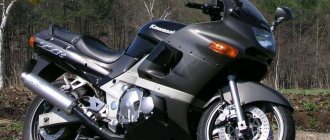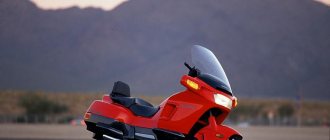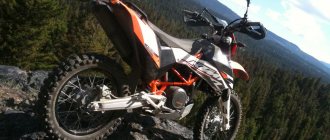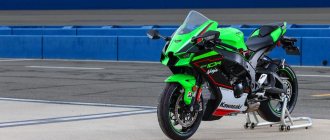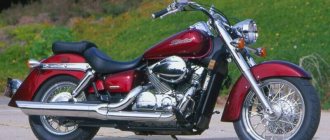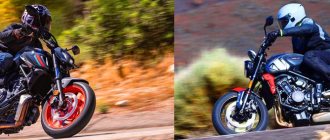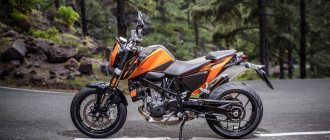The Kawasaki ZZR 250 motorcycle appeared back in 1990. This was a replacement for the outdated GPZ/GPX 250R models. Initially, the motorcycle was sold in Japan, Europe and North America. The model belongs to the “sport tourism” class. The article will give a short review of the Kawasaki ZZR 250 and provide reviews from the owners of this model. It should be immediately noted that this motorcycle has become a true legend of the Japanese motorcycle industry. But let’s not get ahead of ourselves and begin to understand the issue gradually.
Kawasaki ZZR400 - Brief Review
Kawasaki ZZR400 / Kawasaki ZZR400
The sports-touring Kawasaki ZZR400, which appeared in 1990, is distinguished by a successful timeless design and a well-tailored design. “Zizer,” as Russian bikers nicknamed the model, gained wide popularity among beginners. Sporty lines, aerodynamic fairings, easy-going temperament and ease of use are the hallmarks of the Kawasaki ZZR400.
The versatility and practicality of the Zizer allows it to be used comfortably in the city and on long routes. Comfortable fit and acceptable ergonomics do not unnecessarily strain the biker’s muscular system, which is very good on long journeys. With proper and timely maintenance, the Kawasaki ZZR400 will be reliable and provide an unforgettable operating experience.
The 400 cc power plant of the sports “tourist” has a smooth character throughout the entire range of cylinder operation. As Kawasaki ZZR400 owners note, the transmission on these motorcycles is not reliable enough. When using the throttle aggressively, 2nd gear often fails. In 1994, the Kawasaki ZZR400 was slightly modernized, receiving new fairings and other minor changes.
Specifications
| model | Kawasaki ZZR 400 |
| type | sports |
| length | 2,070 mm |
| height | 1 175 mm |
| seat height | 760 mm |
| base | 1,385 mm |
| engine power | 59 (53) hp |
| volume of the tank | 18 l. |
| number of gears | 6 |
| dry weight | 190 kg |
| Full technical specifications here. |
The front tire measures 120/60 by 17 inches. Rear - 160/60 by 17 inches. Gearbox with sequential gear shift principle. Torque is transmitted via chain transmission. The front brake system consists of two discs with a diameter of 310 mm each, placed in a four-piston caliper. The rear wheel has a two-piston caliper with one disc with a diameter of 220 mm. The maximum speed of the Kawasaki ZZR 400 reaches 180 km/h. Although some owners say that it is possible to reach 190 km/h. Acceleration to 100 km/h takes 4.3 seconds.
Engine and fuel system
The four-stroke power unit has an in-line arrangement of cylinders. The parameters are as follows:
- number of cylinders – four;
- volume - 399 cm3;
- piston size and stroke, mm - 57/39;
- number of valves – 16;
- torque, N/m – 39;
- rpm – 11000.
Fuel is supplied through four Keihin cvk 32 carburetors. The power plant uses AI 92 gasoline. The Kawasaki ZZR 400 motorcycle engine is liquid cooled. Started by electric starter. Electronic ignition. Since 2001, the manufacturer has installed a fuel afterburner. According to the passport, the Kawasaki ZZR 400 motorcycle has a fuel consumption of 3.7 liters per 100 km, but in real use it can be more than 5 liters. Repair and spare parts
Due to their prevalence, spare parts for the Kawasaki ZZR 400 motorcycle are available in many specialized stores and workshops. Ordering online is no problem. At the same time, depending on the year of manufacture and country of origin, the price may be different.
- An engine with a mileage of 10–15 thousand km costs about 30,000 rubles.
- Used block of carburetors ZZR 400 - 5,000 rubles.
- A clutch disc on a ZZR 400 made in China costs about 2,000 rubles.
- Turn signals on the ZZR 400 manufactured by Visma cost from 1,300 rubles. for one piece.
- The front fork of a Kawasaki ZZR 400 model 1991 costs about 10,000 rubles.
- A high-quality chain for ZZR 400 - no less than 1,500 rubles.
You can order spare parts using this link.
Read other motorcycle reviews Great review of the Yamaha YBR 250
Repairing the Kawasaki ZZR 400 is not particularly difficult
The ZZR 400 manual draws special attention to owners to the need for daily maintenance. The manufacturer recommends doing a number of manipulations before each trip.
This will not only help preserve the life of components and assemblies, but also prevent serious breakdowns.
Electrical diagram of the Kawasaki ZZR 400 motorcycle.
Open in size.
Kawasaki ZZR 250: reviews
The owners of this motorcycle are happy people. At least, this conclusion can be drawn by analyzing reviews of this motorcycle. The model is almost indestructible. The most important rule, according to the owners, is competent, timely maintenance of the motorcycle, as well as the use of high-quality spare parts and technical fluids.
Sometimes you can come across a review that says that this motorcycle lacks power. This is not entirely true; most likely, this review is left by a person who has already “outgrown” the 250 cc class and the time has come for him to consider a more powerful and voluminous motorcycle. For its engine size, the ZZR 250 is very decent.
Motorcycle design
The main distinguishing feature of the Kawasaki ZZR 400 motorcycle was that this model from its very creation was intended for domestic use in Japan.
Although, due to its width, the “zizer” will be an excellent option for tall people who will “saddle” this two-wheeled “horse”. The model's safety margin is significant.
After all, its frame and chassis are capable of withstanding heavy loads, which can be applied to a six hundred cc engine.
Since its design, this motorcycle model has hardly changed. After all, its production continues successfully to this day.
Only the colors of the bike and the shape of the deflectors on the sides have changed. And in 1993, they decided to make the base a little shorter, naturally reducing the power to 53 horsepower.
The reason for this was the introduction of power restrictions, which, willy-nilly, affected the entire range of motorcycles with an engine capacity of 400 cubic centimeters.
Revolution
The ZZR 250 made a lot of noise back in its day. In fact, he had no worthy competitors in the class. managed to create a successful model. The bike was very popular with customers. It is very strange that other manufacturers (especially Japanese) for a long time did not undertake to create a worthy competitor for this motorcycle model. This passivity of competitors, of course, was to their advantage.
But it would be more interesting for the buyer to choose from several manufacturers rather than buy the uncontested ZZR 250, although there were no complaints about it at all from ordinary motorcyclists. This motorcycle was ahead of its time!
Is it worth buying a Kawasaki?
One of the main advantages of the ZZR 400 motorcycle is its price: for an affordable price you can buy a sport bike, which is used by many professional motorcycle racers. Despite the fact that the model was released more than two decades ago and has undergone virtually no restyling, its design remains relevant to this day, causing admiration not only among motorcyclists, but also among pedestrians.
Before purchasing a motorcycle from the 90s, you should think about searching for and purchasing spare parts if necessary and contacting qualified (and ideally official) car repair centers and dealerships. It is also worth remembering the considerable weight of the motorcycle - more than 200 kilograms, which is why not everyone can handle the bike.
Advantages of Kawasaki ZZR 400:
- The motorcycle was created in full compliance with all the requirements, criteria and standards for sports bikes.
- Affordable cost of motorcycle and spare parts.
- Current and modern design.
Disadvantages of the motorcycle:
- Unreliable transmission, causing complaints.
- Today it is difficult to find a Kawasaki ZZR 400 in good technical condition, without signs of corrosion or deformation.
Summary of six naked bikes
Well, Triumph is the undisputed leader in this comparison. But are its other participants so bad? No and no again! Even the underdog, the old Suzuki SV650, has a lot of fans for its engine. The new Honda CB650R will appeal to those who respect Honda, love in-line fours and are not too worried about the somewhat weak character of this engine. The baby Kawasaki Z650 will be greatly appreciated by short riders; there is nothing to say about the MT-07, it is a wildly popular motorcycle. And the fact that the Aprilia Tuono was higher in the chart is more a merit of Aprilia than a defect of Yamaha.
Well, you already know the rest (about Trident). This is wine.
Is it worth buying a Kawasaki ZZR 400
The undoubted and main advantage of the ZZR is its price. In fact, this model gives you a ticket to a sports biker club for just a penny. At the same time, you can only see the “old man” in a stylish motorcycle with an experienced eye, while ordinary pedestrians will look at the ZZR with admiration.
However, you should understand that we are still talking about a motorcycle from the early 90s, therefore, already in the purchasing process, you should think about finding spare parts and qualified technicians for maintenance and repair. Don't forget about the weight of the motorcycle - the Kawasaki ZZR 400 weighs 200 kg and not everyone can handle it correctly.
To summarize, the ZZR is an excellent choice for beginners who have $2000-5000 to spare, as well as for tuning enthusiasts.
Motorcycle suspension
One of the special features of the Kawasaki ZZR 250 is its lightweight aluminum frame (the first versions of the motorcycle had a steel frame, but after 1992 it was replaced with an aluminum frame). The motorcycle suspension itself is extremely simple, it consists of a conventional telescopic fork, as well as a progressive Uni-Trak monoshock absorber (has a five-stage preload adjustment). The model has disc brakes (single-piston caliper at the rear, four-piston caliper at the front). The suspension does not have any nuances or “blunders”. It can be described as very simple and extremely reliable. The steering wheel is small, like almost all motorcycles in the class, but the bike’s handling is excellent.
Brief history of the model
1990 – start of production and sales of Kawasaki ZZR 400 for the Japanese market. The first generation of the motorcycle. Factory designation - ZX400K. The model is distinguished by a dashboard without a fuel sensor, a 16-liter fuel tank, the absence of inertial supercharging (Ram-Air) and a power of 58 hp. At Japanese auctions it is designated as Kawasaki ZZ-R 400-I. Model: Kawasaki ZZR 400 (Japan). Frame number: ZX400K-000001-007000. Factory designation: ZX400-K1.
1991 – no significant changes. Model: Kawasaki ZZR 400 (Japan). Frame number: ZX400K-007001-017000. Factory designation: ZX400-K2.
1992 – no significant changes. Model: Kawasaki ZZR 400 (Japan). Frame number: ZX400K-017001-. Factory designation: ZX400-K3.
1993 – second generation. Factory designation - ZX400N. The model is distinguished by a dashboard (there is a fuel gauge), a 17-liter fuel tank, the presence of an inertial charging system and a power of 53 hp. (due to changes in Japanese legislation). The headlight can no longer be turned off. The rear brake caliper becomes 1-piston. At Japanese auctions it is designated as Kawasaki ZZ-R 400-II. Model: Kawasaki ZZR 400 (Japan). Frame number: ZX400N-000001-006000. Factory designation: ZX400-N1.
1994 – no significant changes. Model: Kawasaki ZZR 400 (Japan). Frame number: ZX400N-006001-011000. Factory designation: ZX400-N2.
1995 – minor changes to the electrical and ignition system. The front suspension slightly shortens its travel and gets adjustments (preload + rebound). Model: Kawasaki ZZR 400 (Japan). Frame number: ZX400N-011001-015000. Factory designation: ZX400-N3.
1996 – no significant changes. Model: Kawasaki ZZR 400 (Japan). Frame number: ZX400N-015001-. Factory designation: ZX400-N4.
1997 – The dashboard gets green lighting and a clock. Model: Kawasaki ZZR 400 (Japan). Frame number: ZX400N-019001-024000. Factory designation: ZX400-N5.
1998 – Fork protection appears. Model: Kawasaki ZZR 400 (Japan). Frame number: ZX400N-024001-029000. Factory designation: ZX400-N6.
1999 – no significant changes. Model: Kawasaki ZZR 400 (Japan). Frame number: ZX400N-029001-. Factory designation: ZX400-N7.
2000 – model not produced. 2001 – the engine was brought into compliance with updated environmental emission standards. Slight reduction in power. The carburetors receive throttle position sensors (K-TRIC) and an accelerator pump. Standard sprockets change from 15 and 52 teeth to 17 and 46. Model: Kawasaki ZZR 400 (Japan). Frame number: ZX400N-033001-036000. Factory designation: ZX400-N8.
2002 – model not produced. 2003 – no significant changes. Model: Kawasaki ZZR 400 (Japan). Frame number: ZX400N-036001-. Factory designation: ZX400-N9.
2004 - the model receives new front brake calipers (black). Model: Kawasaki ZZR 400 (Japan). Frame number: ZX400N-040001-042000. Factory designation: ZX400-N10.
2005 - starting this year, the model is available with a black engine. Model: Kawasaki ZZR 400 (Japan). Frame number: ZX400N-042001-. Factory designation: ZX400-N11.
2006 – no significant changes. Model: Kawasaki ZZR 400 (Japan). Frame number: ZX400N-044001-. Factory designation: ZX400-N6F.
2007 – no significant changes. Last year of release. Model: Kawasaki ZZR 400 (Japan). Frame number: ZX400N-044001-. Factory designation: ZX400-N6S.
ZZR 400 and ZZR 400 2, what is the difference?
The dashboard of older models did not have a fuel level sensor.
During its 27 years of production, the ZZR 400 experienced only one generation change. In 1993, the Japanese government revised laws regarding restrictions on motorcycles. In the second half of that year, Kawasaki released the second generation ZZR 400 and ZZR 600 .
Initially, restyling was planned, but the color scheme for the model changed every few months. There were a lot of differences, so the release of a new generation was announced.
94 years old.
He is well preserved for his age, and he is soon 25 years old.
Our editorial '94 ZZR 400. This is the owner's first motorcycle. He already wants something more powerful.
The ZZR 400 has 2 series:
- the power plant was cut from 58 to 53 hp;
- the headlight began to shine constantly when the ignition was on;
- the gas tank was increased by 1 liter, to 17 ;
- weight increased by 2 kg and amounted to 192 kg;
- a fuel level sensor appeared.
The front panel cladding has changed and a fuel gauge has appeared.
The new generation received the index 400 II (In the factory version of the number, Roman designations are used.)
Interestingly, depending on the year of manufacture, the second generation could have additional options enabled by default:
- 97 models received different instrument panel lighting (changed to green) and a digital clock;
- in the 2000s, several changes were applied at once - the emblem on the tank became voluminous, control over the purification of exhaust gases appeared, the frame began to be painted in monochromatic colors, and the oil filter was removed (the older one has it).
In addition, some motorcycles received undocumented changes that slightly increased the performance parameters.
009_moto_0211_040
The same problem can occur in the first generation. But here the airbox itself is visible to the naked eye, which can also “leak” along the seams. The same problem can occur in the first generation. But here the airbox itself is visible to the naked eye, which can also “leak” along the seams.
(-) Another possible cause of “floating” idle is a malfunction of the relay regulator. Low voltage confuses the ignition control unit. True, this “jamb” may not come out immediately, but after the battery runs out without proper charging (usually after half an hour or an hour of engine operation, and this is immediately visible from the dim light of the headlight). The relay itself, as a rule, “gives up” when using a faulty battery. The operation of the charging system is checked simply: at engine speeds above 4000, the voltage at the battery terminals must be at least 14.5 V.
Flaws
The heavy weight lengthens the braking distance, but at the same time, the low seating position appealed to both beginners and seasoned riders.
- Transmission. Due to an incorrectly configured sequential gearbox, the motorcycle had to be repaired frequently. Particular complaints about the second and fourth gears. If the previous user actively used the clutch, the new owner will have to immediately start at the service station. Transmission overhauls are performed in Russia, but this pleasure is not cheap.
- Mirrors. Some users noted that the rounded and sporty contours of the bike make them look unnaturally large. At the same time, it was noted that their size gives a complete picture of the situation on the road.
Indeed, the mirrors look simply huge.
- Killed. Since the model left the assembly line more than 10 years ago, when purchasing, the owner must be prepared that the machine will require financial investments.
- Interesting minus o. After 120 km, further acceleration is very sluggish. “It’s like there’s a poltergeist holding the frame from behind.”
Video
- Test drive of a Kawasaki ZZR400 motorcycle from a former owner.
- Review of the Kawasaki ZZR400 motorcycle.
Kawasaki ZZR 400
— a sports touring motorcycle for beginners. Despite the fact that the first release of the ZZR400 was released back in 1990, and already in 1993 the ZZR 400-2 modification went into production, this bike is still extremely popular. However, the popularity of the famous “Zizer” is deservedly so, because this motorcycle, despite some weak points, at one time gave people what they needed - an inexpensive sports tourer with excellent characteristics. The ZZR 400 is designed for those who want to join the class of sports touring bikes, but for safety or financial reasons do not want to immediately buy a more powerful model. But ZZR 400 is usually available in bulk on the secondary market, there is plenty to choose from! True, you need to choose carefully - since this is a motorcycle for beginners, it rarely stays in the same hands for years, and quite often changes owners. And who knows how each of the previous owners looked after it?
ZZR 400As we said just above, the high popularity of the Kawasaki ZZR 400 is due not least to the low price for a used copy. But from a technical point of view, the ZZR 400 is a very interesting bike. The engine, of course, does not amaze the imagination with its characteristics, but the liquid-cooled inline four is capable of producing from 53 to 59 horsepower and 37 nm of torque, depending on the year of manufacture of the motorcycle. The engine loves to rev - peak power occurs at around 9000 rpm, which is quite typical for a 400 cc in-line internal combustion engine. The maximum speed of the Kawasaki ZZR 400 is 190 km/h.
The developed plastic tail provides excellent wind protection - thus the ZZR 400 hints at its touring aspirations. However, it is also good in the city - short-wheelbase and not too heavy (the dry weight of the Kawasaki ZZR 400 is 197 kg), it maneuvers well, and three disc brakes provide the motorcycle with very effective deceleration if necessary. The motorcycle accelerates from 0 to 100 km/h in five and a half seconds - an average figure. However, the comfortable cruising speed of the ZZR 400 is around 120 km/h. Of course, it can do more, but gasoline consumption will increase very significantly, and the simple design of the motorcycle will not thank you if you constantly operate the bike in such extreme conditions. By the way, the gas tank volume of the ZZR 400 is 18 liters, and consumption fluctuates around 8 liters in the combined cycle. Kawasaki ZZR400 According to reviews from Kawasaki ZZR 400 owners, the weak point of the motorcycle is its gearbox. In general, the six-speed transmission of a sports tourer works well and quite clearly, but due to the design features it quickly becomes loose, extraneous sounds appear, and gears begin to shift noticeably less clearly. Well, the famous “sore” of the ZZR 400 - the second gear falling out
This, of course, can all be repaired, but when buying a used Zizer, you should pay special attention to diagnosing the transmission
Despite being a completely legitimate sport-tourer, the Kawasaki ZZR 400 sometimes has some difficulties on the track. The power of its engine is noticeably not enough for dynamic acceleration after the hundred km/h mark, and if you also drive with a passenger and cargo, it becomes completely sad. But if you don't like to go fast, and you are attracted by the style of this motorcycle, which is also available at a low price, this will not be a disadvantage. Moreover, even now, a quarter of a century after the first Kawasaki ZZR 400 was released, this motorcycle does not look archaic. We can safely say that it is perfect as a first motorcycle for a sports touring enthusiast.
Advantages
Users consider the light and at the same time massive frame to be the main advantage.
The motorcycle is quite popular in our time, not least because of the low price for a used copy.
It has the first quality due to special aluminum alloys, and the second from its relative - the older model. Since the ZZR 600 was already released during the development of the motorcycle, many details were transferred from it. The frame is designed for a larger engine, so 400 owners had nothing to worry about.
Another plus was the foresight of Kawasaki's design department, who managed to create a model that, 25 years later, looks modern and sleek.
Back view.
Side view.
View from above.
The big advantage is the affordable price of the motorcycle and components.
Despite being developed for the domestic market, the Kawasaki ZZR 400 is well suited not only for short Asians, but also for Europeans of medium and tall stature. Tests have shown that even people 190 cm tall are quite comfortable on a motorcycle.
What do the owners say?
Connoisseurs of retro classics speak positively about this bike. For many, it, like other representatives of the class, has become a replacement for road motorcycles. Indeed, this technique is perfect for urban conditions, because it is leisurely and measured in dynamics.
Judging by the reviews, the motorcycle leaves a pleasant impression with its smooth ride and characteristic sounds when the engine is turned on and running. Those who have previously ridden really old bikes, which are almost half a century old, say that they don’t feel much difference in the sensations.
In conclusion, it is worth noting that the Kawasaki W400 is an excellent example of how to properly make an antique motorcycle. The appropriate appearance and characteristics are combined with modern safety and comfort measures. So if you want to touch the retro classics, this is one of the best options.
Always modern design Kawasaki ZZR
The exterior of this model, even taking into account the time that has passed since the creation of the motorcycle, is considered very fresh and ultra-modern.
And this is a full credit to the design department of KAWASAKI, who were able to look into the future and do the incredible - to foresee the fashion trends of sports motorcycles for decades to come.
The fairings are bulky and massive at the same time, and therefore allow you to capture the driver in their “embraces” to create ideal aerodynamic conditions.
After all, this is the only way to achieve a comfortable ride at high speeds.
The instrument panel is very simple and concise. It is presented in the form of ordinary numbers and arrows.
Nothing superfluous - a classic of the genre. To create a sporty ambience, a chrome-plated exhaust pipe and textured steel brake discs are used.
Although the huge mirrors look a little ridiculous in the general plan, which only spoils the harmonious integrity of the picture.
Approximate cost
The cost of the new model will be approximately 500,000 rubles.
Whereas a formerly used unit will also be able to satisfy the wishes of not only the amateur, but also the professional.
In general, a motorcycle of this used model costs $4,000 – $5,000. It all depends on the year the bike was manufactured, its condition, and mileage.
The affordable price of the Kawasaki ZZR 400 motorcycle will allow you to become a member of a sports biker club.
After all, it is very difficult to guess from its appearance that this is a very old model. Only experts can do this. And therefore, ordinary passers-by will glance at your bike with admiration.
In this case, you must immediately look for a good service station and repairmen for such a vehicle.
Considering the fact that the Kawasaki ZZR 400 motorcycle model weighs 200 kg, not everyone can control it
This is worth paying special attention to. The world's love and preference for the Kawasaki ZZR 400 model allows us to say that this is one of the most successful motorcycles.
The world's love and preference for the Kawasaki ZZR 400 model suggests that this is one of the most successful motorcycles.
He will be a great friend for a beginner as he gains his first motorcycle riding experience.
After all, here high technical characteristics and ultra-modern design merged in an ideal tandem, which was significantly ahead of the time of its creators.
This type of sport-tourist class transport is comfortable and convenient not only when traveling around the city, but also when traveling long distances.
At the same time, all conditions for reliable protection from the wind and comfortable landing will be met.
Moreover, the Kawasaki ZZR 400 motorcycle will need only 5 seconds to accelerate to 100 km/h.
Therefore, this is a unique model that can compete with modern sports cars.
And if you consider that this model uses a massive rigid frame, suitable suspension and the most effective braking system, then this motorcycle can be classified as a sports class model.
Reviews of Kawasaki ZZR Rating: 4.4 out of 5 11 reviews found
26.02.2013
Hello everyone. I want to share my experience of owning a Kawasaki zzr1100-2. The fall of 2011 came and I decided to sell my Kawasaki zr-7 (a review has been written) and buy something more powerful and more windproof.) During the winter I decided on the models, these are: Kawasaki zx12r, zzr1200, zzr1100. I wanted a sport tourer with a powerful engine and good wind protection. Having accumulated the required amount, I began to intensively monitor the Internet. The preference was zx12r, but there were no adequate price tags.... either firewood or inflated prices, but I didn’t want to overpay. There was not a bad offer for the zx12r, but the seller was stupid and I decided to refuse, the zzr1200 was also inspected, I didn’t like its condition either. And already in April I decided to stop at zzr1100 because... The offer wasn’t bad, and the snow was almost gone and I really wanted to go skiing! In the end, we went, looked, bought! It was 400 km from home, so it was time to get comfortable and get used to it. After filling out the paperwork and paying, we went home. First impressions are that the bike is very wide and you have to reach for the steering wheel, but at the same time the seating position is comfortable. Having driven out onto the highway I immediately appreciated the stability, the bike goes like a glove. Somewhere after 200 km of travel I already felt numbness in my body, then this feeling came more and more often (it was winter and I was not used to this class of motorcycles). When I got used to it, I tried to unscrew it to 9t/rpm with the second one, the sensations are indescribable! I slid almost into the back seat and, clutching the steering wheel, quickly slowed down. When I got home, I barely got off the bike, my whole body ached, my hands hurt. but the delight remained) Then the 2012 season went into full swing. Every good day I went on trips from 50 to 350 km, long-distance trips were in the plans, but... it never happened. Every time I went out for a ride, I could not get enough of its power, wind protection and stability. I had a high glass and at 160-180 km/h I didn’t have to bend down, but at 140 km/h it was absolutely awesome (my height/weight is 187/85). There was always enough power, it’s very nice to overtake and know that you will always have time, this never happened on the zr-7. Once I quickly accelerated with the second number from a standstill to 80 km/h, so then his hands were shaking))) Many people write about being reluctant to take turns, I can say that everything is fine with him, it’s just a sport tour and not a sport -bike, so it should be assessed as a heavy sports tour. For me, it always entered and exited turns along a clearly defined trajectory, both at 60 and at 160 km/h, you just need to soberly assess your capabilities and speed, and not try to do the impossible. The maximum I accelerated on it was 220 km/h, because... I’m not a fan of frantic pace and speed records, I prefer a comfortable and at the same time fast ride, but I think it will go 300 km/h. At speed, the bike behaves perfectly, it doesn’t throw or wobble, it just lies down on the tank and rolls 200+ and that’s it. I didn’t really like the brakes, they slow down 250 kg well, but it feels like they’re kind of weak (maybe it’s just like that on mine). The more I rolled into the moto, the more I got used to the landing. The seating position is, in principle, comfortable, especially at speeds over 200+, and you don’t need anything else, but my hands still ached after long trips. Driving with the second number does not cause any inconvenience. I didn’t like the headlights; I wasn’t very confident in driving in the dark. Instrument readings are easy to read at any time of the day. The engine and gearbox operate smoothly. Many people criticize the Zizer gearbox; on my motorcycle it worked very smoothly and clearly. Of course, there are those who buy zizers that have been killed in the trash and even squeeze everything out of it, thinking that there is a fresh sport underneath and they naturally break down, and then they spit in the direction of zizers and the Kawasaki company in general. I can say that this is already my 5th motorcycle from this company and everything went well, didn’t break down and brought only pleasure. More than once I had to drive through Moscow traffic jams, both very thick and thin) I can say that it is quite normal. Of course, when you stand for a long time in dense traffic jams where you can’t drive between one row and all the time you have to change lanes from row to row and often work the clutch and brake, then of course your hands buzz, but this bike is not really for that. If you only ride around the city, then of course you need to consider another motorcycle. About putting it on the rear step - it’s very easy to put it on (some people just write that you won’t put it on). Once it fell near my garage, I picked it up alone without any problems. Once we went to the Volga: forest, sand, mud, huge puddles and holes, and this road was about 10-15 km long. Of course, the Zizer is not at all for such roads, but even on them I drove quite normally. It’s true that I got tired of washing it later, especially the radiator. Its tank is 24 liters, and when driving 140-180 km/h the consumption is 6-7 liters per 100 km, so the tank is enough for 300-350 km, and if you drive 120-140 km then even more. The suspensions are good, it is a sport tourer, but when cornering on bad asphalt at speed the bike wobbles a little, which is affected by the long wheelbase and soft suspensions. There is a very small glove compartment under the saddle; there is room for a small bottle of lubricant, a tool, and a rag. So the case is a very useful thing! During the season I drove about 8k, there were no breakdowns. I sold it in the fall. Of course, I didn’t really want to sell, but I needed money. In the winter I bought a zrx1100 for the occasion, so I’m waiting for the season. To summarize, I can say that the Kawasaki zzr1100 is a very good and powerful motorcycle. From the design, of course, it is clear that it is from the 90s, but its potential still amazes us today. This motorcycle undoubtedly deserves respect. If you use it for its intended purpose, it will bring only positive emotions.
Tuning and modification of a plastic Japanese samurai.
The Kawasaki ZZR 400 has very decent technical characteristics, so owners often pay attention to improving the aesthetic side of their motorcycles - stickers and so on. However, installing a direct-flow muffler instead of the standard system is also popular, since the sound of the Kawasaki ZZR leaves much to be desired - a kind of inexpressive squealing
But with an aftermarket exhaust like the Acrapovic or Two Brothers, the ZZR 400's sound changes dramatically. There are also options for replacing some transmission elements with reinforced ones, which eliminates the problem with second gear, which sooner or later inevitably arises on all “Zizers”. True, the set of parts required for this operation costs a lot, so most owners leave everything as is. So most often in the case of the Kawasaki ZZR 400, tuning comes down to replacing the exhaust with a louder one and pasting the motorcycle with different stickers. Sometimes the suspensions are changed to more modern ones, but this solution also cannot be classified as a budget solution.
Analysis of the technical characteristics of the Kawasaki ZZR 400
Over the many years of presence on domestic roads, the ZZR has been studied far and wide by motorcyclists: all of its positive and negative qualities have been identified. Based on reviews of the Kawasaki ZZR 400, one can conclude that the 400 cc engine is reliable and unpretentious, which cannot be said about the gearbox. With active and aggressive driving, it will have to be repaired every 30-40 thousand km; with moderate driving, the normal service life will last up to 50 thousand.
The cost of fixing the problem will cost the owner approximately 600-700 dollars, of which about 500 will be spent on spare parts, and 200 on the work of craftsmen. Signs of gearbox wear include incorrect shifting of second gear.
Owners of the Kawasaki ZZR 400 note the reliability and wear resistance of the frame structure. The reason is hidden in the fact that it was developed for a bike with a more powerful engine. Motorcycle owners have also identified a common problem of oil leakage due to damage to the clutch drive.
Bike appearance
The design of the motorcycle is in the classic Japanese sports spirit. The model is characterized by smooth lines and shapes. There is a certain aggressiveness in the appearance of the motorcycle. Also striking is the factory colorful color scheme of the model. Although from the first glance at the motorcycle it becomes clear that this is a model from the “sport-tourism” class. It must be said that the bike looks stylish and aggressive, in no small part due to its specific alloy wheels. It is worth noting that in the first releases of the model the wheels were more interesting than those of later models. But perhaps this is just a matter of taste.
Main competitors
- The Suzuki RF 400, produced from 1993 to 2000, is one of the most common competitors of the Zizer. These two models are almost identical in specifications, and both have their pros and cons. However, the ZZR 400 is much more common, which can undoubtedly be considered one of its advantages. If the RF 400 needs repairs, you are unlikely to find spare parts in stock.
- Honda VFR 400, in different versions and under different names (RVF 400) produced from 1986 to 2001. The first generation of this motorcycle can boast of terrifying acceleration dynamics, which sets it apart from other 400 cc sports tourers. However, due to its advanced age, finding such a copy in good condition is quite problematic, and the latest generation, produced since 1994, is comparable to the ZZR 400 in all respects.
History of the motorcycle
The ZZR 400 motorcycle was created by the well-known company KAWASAKI as a variant of a sports and touring two-wheeled vehicle.
This is clearly confirmed by the code ZZ-R in the name.
After all, it is he who indicates a sports orientation.
This model was popularly called “Zizer”.
And since its first appearance on the market, the model has become extremely popular. This was in 1990.
Preference for a motorcycle was given not only by speed riding enthusiasts, but also by professionals in this matter.
After all, the simultaneous combination of technical characteristics and unique sporty design left no one indifferent.
So, today the design of the Kawasaki ZZR (Kawasaki ZZR) 400 is quite relevant.
End of the ZZR era
Nothing can last forever. The Kawasaki ZZR 250 replaced outdated models and eventually became outdated itself. The last copy of this motorcycle was released in 2007. And a year later, the manufacturing company presented customers with the successor to this model; it became the Kawasaki Ninja 250R.
It is worth noting that there are still plenty of ZZR 250 motorcycles on the secondary market. It is quite possible to find a motorcycle in very decent technical condition for a relatively moderate amount. Buyers choose this model on the secondary market for its incredible reliability; in addition, spare parts for the Kawasaki ZZR 250 are inexpensive and are almost always either in stock or quickly delivered by specialized stores. The motorcycle is not a problem.
Technical characteristics and parameters.
The reason why the Zizer is still so popular lies on the surface - for a modest amount the buyer gets a really peppy motorcycle. Its liquid-cooled 4-cylinder engine is a little weak at low end, but delivers excellent performance at mid to high revs. And in general, the Kawasaki ZZR 400's technical characteristics fully correspond to its class - it is a nimble and at the same time very comfortable sports tourer. At the same time, the maximum speed of the Kawasaki ZZR 400 is 190 km/h, if, of course, the motorcycle is in good technical condition. Another thing is that in this mode it will empty the gas tank dry in 130-140 kilometers, if not less.
The bike has a 6-speed transmission, and the first two gears are quite short, so you will have to shift frequently, especially when driving around the city. This has a plus - the Kawasaki ZZR 400 motorcycle can be an excellent “study desk” for a novice biker. He is obedient and flexible enough so as not to provoke a beginner into dangerous road experiments, but with skillful handling he is capable of delivering such a dose of adrenaline that it will definitely not seem too much. This is where its main advantage lies – balance.
Economical
The fuel consumption officially declared by the manufacturer for the Kawasaki ZZR 250 is 3.2-4.9 liters of gasoline for every hundred kilometers. This is in theory, in practice it comes out to about 4.5-6.0 liters per hundred kilometers (average). But the exact fuel consumption value always depends on your riding style, the quality of gasoline and the health of your motorcycle. In any case, the motorcycle is not too power-hungry, but it cannot be called an economical bike either; in this regard, everything is usual, without surprises (pleasant or unpleasant).
It should be noted that the bike is quite loyal to Russian fuel. This is very important because some motorcycle models are very sensitive to poor quality fuel, and all this can lead to serious problems with the bike’s fuel system, but with the ZZR 250 there will be no such problems.
Specifications
Technical characteristics of Kawasaki ZXR 400:
| Model | Kawasaki ZXR400 |
| Motorcycle type | sports |
| Year of issue | 1989-1999 |
| Frame | aluminum diagonal |
| engine's type | 4-cylinder, 4-stroke, in-line |
| Working volume | 398 cm³ |
| Bore/Stroke | 57.0 x 39.0 mm |
| Compression ratio | 12.1:1 |
| Cooling | liquid |
| Number of valves per cylinder | DOHC, 4 valves per cylinder |
| Fuel supply system | Carburetor, 4x Keihin CVKD32 – ZX400H, ZX400L Carburetor, 4x Keihin CVKD30 – ZX400L3-L9 (Japanese versions) Carburetor, 4x Keihin FVKD32 (flat throttle) – ZX400J, ZX400M |
| Ignition type | transistor |
| Maximum power | 62.0 hp (45.6 kW) at 12500 rpm - ZX400H, ZX400J with inertial charging 59.0 hp (43.0 kW) at 12000 rpm - without inertial boost 65.0 hp (47.8 kW) at 13,000 rpm - ZX400L, ZX400M with inertial charging 53.0 hp (39.0 kW) at 12000 rpm – ZX400L3-L9 (Japanese versions) |
| Maximum torque | 39.2 Nm (4.0 kg*m) at 10,000 rpm – ZX400H, ZX400J 36.3 Nm (3.7 kg*m) at 12,000 rpm – ZX400L, ZX400M |
| Clutch | Multi-disc in oil bath, cable drive |
| Transmission | 6-speed |
| type of drive | chain |
| Front tire size | 120/60 R17 55H |
| Rear tire size | 160/60 R17 69H |
| Front brakes | 2 discs, 300 mm, 4-piston calipers – ZX400H, ZX400J 2 discs, 310 mm, 4-piston calipers – ZX400L, ZX400M |
| Rear brakes | 1 disc, 220 mm, 2-piston caliper |
| Front suspension | Inverted fork (adjustable), travel – 120 mm – ZXR400 Inverted fork (all adjustments), travel – 120 mm – ZXR400R |
| Rear suspension | Uni-Trak pendulum with monoshock absorber (adjustable), travel – 140 mm – ZX400H, ZX400J Uni-Trak pendulum with monoshock absorber (adjustable), travel – 120 mm – ZX400L, ZX400M |
| Motorcycle length | 2035 mm – ZX400H 2025 mm – ZX400J 1995 mm – ZX400L, ZX400M |
| Motorcycle width | 705 mm – ZX400H, ZX400J 710 mm – ZX400L, ZX400M |
| Motorcycle height | 1125 mm – ZX400H, ZX400J 1080 mm – ZX400L, ZX400M |
| Wheelbase | 1395 mm – ZX400H, ZX400J 1385 mm – ZX400L, ZX400M |
| Seat height | 765 mm – ZX400H, ZX400J 760 mm – ZX400L, ZX400M |
| Minimum ground clearance | 120 mm – ZX400H, ZX400J 115 mm – ZX400L, ZX400M |
| Acceleration to 100 km/h | 4.3 sec. |
| Maximum speed | 180 km/h (Japanese versions, with limiter) |
| Gas tank capacity | 16.0 l |
| Motorcycle weight (dry) | 162 kg – ZX400H 160 kg – ZX400J, ZX400L 159 kg – ZX400M |
015_moto_0911_048
Yamaha XTZ660 Ténéré: touring enduro, 1991–1997, 660 cm³, 46 hp, 195 kg, RUB 100,000–160,000. Yamaha XTZ660 Ténéré: touring enduro, 1991–1997, 660 cm³, 46 hp, 195 kg, RUB 100,000–160,000.
| Estimated cost of spare parts for Kawasaki KLE400/500 | ||
| Name | Original spare parts, rub. | Non-original spare parts, rub. |
| Safety bars | — | from 135 Euro (SW-Motech) |
| Reinforced brake hose (set) | — | 1900 (Venhill) |
| Brake pads (set) | 8100 | 2400 (CL Brakes) |
| Oil filter | 465 | 320 (Hiflo) |
| Spare parts, mostly available in stock. | ||
| Spare parts, mainly imported to order. |
The motorcycle for the shooting was provided by the Drivebike motorcycle dealership.
Atypical hybrid: Kawasaki KLE500
